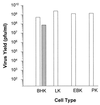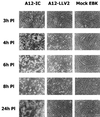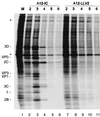Ability of foot-and-mouth disease virus to form plaques in cell culture is associated with suppression of alpha/beta interferon
- PMID: 10559301
- PMCID: PMC113038
- DOI: 10.1128/JVI.73.12.9891-9898.1999
Ability of foot-and-mouth disease virus to form plaques in cell culture is associated with suppression of alpha/beta interferon
Abstract
A genetic variant of foot-and-mouth disease virus lacking the leader proteinase coding region (A12-LLV2) is attenuated in both cattle and swine and, in contrast to wild-type virus (A12-IC), does not spread from the initial site of infection after aerosol exposure of bovines. We have identified secondary cells from susceptible animals, i.e., bovine, ovine, and porcine animals, in which infection with A12-LLV2, in contrast to A12-IC infection, does not produce plaques; this result indicates that this virus cannot spread from the site of initial infection to neighboring cells. Nevertheless, A12-LLV2 can infect these cells, but cytopathic effects and virus yields are significantly reduced compared to those seen with A12-IC infection. Reverse transcription-PCR analysis demonstrates that both A12-LLV2 and A12-IC induce the production of alpha/beta interferon (IFN-alpha/beta) mRNA in host cells. However, only supernatants from A12-LLV2-infected cells have significant antiviral activity. The antiviral activity in supernatants from A12-LLV2-infected embryonic bovine kidney cells is IFN-alpha/beta specific, as assayed with mouse embryonic fibroblast cells with or without IFN-alpha/beta receptors. The results obtained with cell cultures demonstrate that the ability of A12-IC to form plaques is associated with the suppression of IFN-alpha/beta expression and suggest a role for this host factor in the inability of A12-LLV2 to spread and cause disease in susceptible animals.
Figures







Similar articles
-
Type I interferon production in cattle infected with 2 strains of foot-and-mouth disease virus, as determined by in situ hybridization.Can J Vet Res. 2000 Apr;64(2):130-3. Can J Vet Res. 2000. PMID: 10805253 Free PMC article.
-
Protection of swine by live and inactivated vaccines prepared from a leader proteinase-deficient serotype A12 foot-and-mouth disease virus.Vaccine. 1998 Oct;16(16):1516-22. doi: 10.1016/s0264-410x(98)00029-2. Vaccine. 1998. PMID: 9711798 Free PMC article.
-
Pathogenesis of wild-type and leaderless foot-and-mouth disease virus in cattle.J Virol. 1996 Aug;70(8):5638-41. doi: 10.1128/JVI.70.8.5638-5641.1996. J Virol. 1996. PMID: 8764079 Free PMC article.
-
The leader proteinase of foot-and-mouth disease virus inhibits the induction of beta interferon mRNA and blocks the host innate immune response.J Virol. 2006 Feb;80(4):1906-14. doi: 10.1128/JVI.80.4.1906-1914.2006. J Virol. 2006. PMID: 16439546 Free PMC article.
-
Evaluation of a live-attenuated foot-and-mouth disease virus as a vaccine candidate.Virology. 1997 Jan 6;227(1):96-102. doi: 10.1006/viro.1996.8309. Virology. 1997. PMID: 9007062
Cited by
-
Bovine type III interferon significantly delays and reduces the severity of foot-and-mouth disease in cattle.J Virol. 2012 Apr;86(8):4477-87. doi: 10.1128/JVI.06683-11. Epub 2012 Feb 1. J Virol. 2012. PMID: 22301155 Free PMC article.
-
Different strains of Theiler's murine encephalomyelitis virus antagonize different sites in the type I interferon pathway.J Virol. 2010 Sep;84(18):9181-9. doi: 10.1128/JVI.00603-10. Epub 2010 Jul 7. J Virol. 2010. PMID: 20610716 Free PMC article.
-
The Different Tactics of Foot-and-Mouth Disease Virus to Evade Innate Immunity.Front Microbiol. 2018 Nov 12;9:2644. doi: 10.3389/fmicb.2018.02644. eCollection 2018. Front Microbiol. 2018. PMID: 30483224 Free PMC article. Review.
-
The Pathogenesis of Foot-and-Mouth Disease in Pigs.Front Vet Sci. 2016 May 23;3:41. doi: 10.3389/fvets.2016.00041. eCollection 2016. Front Vet Sci. 2016. PMID: 27243028 Free PMC article. Review.
-
Novel viral disease control strategy: adenovirus expressing alpha interferon rapidly protects swine from foot-and-mouth disease.J Virol. 2003 Jan;77(2):1621-5. doi: 10.1128/jvi.77.2.1621-1625.2003. J Virol. 2003. PMID: 12502879 Free PMC article.
References
-
- Bachrach H L. Foot-and-mouth disease: world-wide impact and control measures. In: Kurstak E, Maramorosch K, editors. Viruses and environment. New York, N.Y: Academic Press, Inc.; 1978. pp. 299–310.
-
- Brown F. New approaches to vaccination against foot-and-mouth disease. Vaccine. 1992;10:1022–1026. - PubMed
Publication types
MeSH terms
Substances
LinkOut - more resources
Full Text Sources
Other Literature Sources

